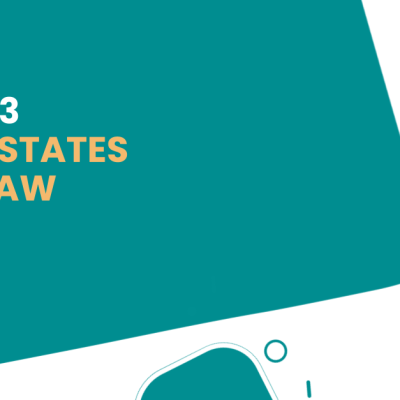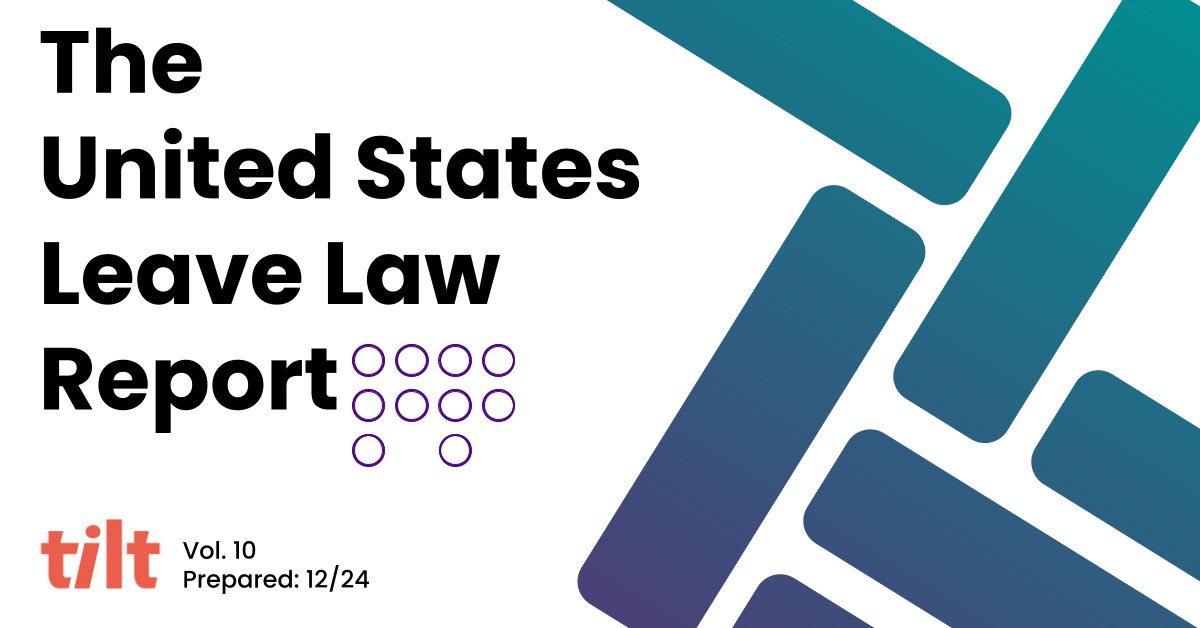As leave law experts we know that keeping up to date with the latest changes can be a serious pain in the (you know what). We’ve made it easy for you though because we’re just that kind.
Check out Vol. 3 of The United States Leave Law Report and get the latest breakdown of the updates state-by-state. We also made a downloadable version for you too if you want to share the knowledge because we’re cool like that.
Looking for all the insightful goodies from our previous volumes? See what you might have missed here.
Status of National Paid Family and Medical Leave
Although public support for a national paid family and medical leave program remains high, a split Congress in 2023 may reduce the likelihood of a comprehensive legislative solution in the near term. Instead, we expect the states to continue to lead the way with paid family and medical leave programs.
NEW: National Protections Pregnant Workers Fairness Act
After a 10 year fight, Congress just passed the Pregnant Workers Fairness Act (PWFA) by including it in the FY23 omnibus spending bill, which President Biden signed into law on December 29, 2022.
The PWFA is closely modeled after the Americans with Disabilities Act (ADA) and requires private employers with 15 or more employees to provide reasonable accommodations to employees affected by pregnancy, childbirth or related medical conditions. A reasonable accommodation may include a paid or unpaid leave of absence, but employers can’t require qualified employees to take leave if another (non-leave) reasonable accommodation would work.
There are 30 states that already offer protections similar to those under the national PWFA. Employees in those states will enjoy the protection of whichever law is most beneficial to them. For example, California’s Pregnancy Disability Leave Law (CA PDL) already requires up to four months of unpaid pregnancy disability leave, so a CA employee is entitled to at least four months of pregnancy disability leave if medically necessary, and additional time can be considered as part of the interactive process under PWFA. As for the other 20 states, this is a new and very important development for employers!
Status of State Paid Family and Medical Leave
At present, seven states (California, Connecticut, Massachusetts, New Jersey, New York, Rhode Island, and Washington) plus Washington D.C. have mandatory family and medical leave programs paying benefits to eligible employees. Four other states have passed legislation mandating paid leave in the near future: Oregon (September 2023), Colorado (2024), Maryland (2025) and Delaware (2026).
We’ve also noticed a developing trend: more states are treating paid medical and family leave as an insurance product that can be voluntarily purchased by employers and/or employees. New Hampshire, Vermont and Virginia have recently taken this approach, and other states (including Arizona, Minnesota, Pennsylvania and South Dakota) have been considering it. These voluntary programs can certainly benefit employees who have access to them and the resources required to participate–but many workers (particularly lower wage workers) might not find these voluntary programs especially helpful.
California Here We Come
The California Family Rights Act (CFRA) provides unpaid, job-protected time off to eligible employees for certain military family reasons, new child bonding, caring for one’s own medical condition or caring for a family member with a medical condition. CFRA already defined “family member” broadly, but as of January 1, 2023, the definition now includes a designated person, which is “any individual related by blood or whose association with the employee is the equivalent of a family relationship.” In other words, CFRA leave will be available to care for close loved ones who aren’t biologically or legally related to the employee.
Also, as of January 1, California employers with five or more employees are required to provide at least five days of unpaid bereavement leave to eligible employees for the death of a “family member” which is defined as a spouse, child, parent, sibling, grandparent, grandchild, domestic partner or parent-in-law of the employee. Employees are eligible if they have worked for at least 30 days for their employer. The leave can be taken intermittently, but must be completed within 3 months of the family member’s death.
Call on Colorado
Although Colorado’s Family and Medical Leave Insurance (FAMLI) Program doesn’t start paying benefits to employees until 2024, Colorado employers should ensure they are complying with current FAMLI requirements, including:
- Notifying employees about the program
- Paycheck deductions to collect premiums as of January 1, 2023.
Colorado employers will also need to register in the My FAMLI+ Employer portal before April 30, 2023. Colorado will open up a private plan application process by October of next year, for employers who may wish to opt out of the state program.
Beginning January 1, 2024, FAMLI will provide eligible employees with up to 12 weeks of paid leave for certain family, medical, military and safety reasons, and up to 16 weeks if additional time is needed due to complications related to pregnancy or childbirth. Most workers in Colorado will be eligible for FAMLI benefits when the program goes live, as its earning threshold is low: $2,500 in wages earned in Colorado within a year.
D is for Delaware:
Beginning in July 2026, Delaware will provide eligible employees with up to 12 weeks of partially paid parental leave in a year, and up to 6 weeks in a 24 month period for employees to care for themselves or a close family member with a serious health issue, or for certain military family reasons.
D Is Also for District of Columbia (D.C.)
As of October 1, 2022, the number of paid weeks of leave available for eligible employees under D.C.’s Universal Paid Leave Act increased to 12 weeks for family, parental and medical reasons (with an additional 2 weeks for prenatal care if necessary). Before that date, D.C. offered 6 weeks of benefits to employees needing leave to care for their own, or a family member’s, serious health condition, and 8 weeks for parental leave (with an additional 2 weeks for prenatal care if necessary).
The Noise From Illinois
Effective January 1, 2023, the state’s existing Child Bereavement Leave Act was renamed the Family Bereavement Leave Act. The amended law provides employees with up to two weeks (10 workdays) of unpaid bereavement leave for certain reasons related to the death of a child, stepchild, spouse, domestic partner, sibling, parent, parent-in-law, grandchild, grandparent or stepparent. Time off will also be available for pregnancy loss, failed adoptions, unsuccessful reproductive procedures, or a diagnosis that negatively impacts pregnancy or fertility.
More on Maryland
Starting in January 2025, Maryland will offer eligible employees up to 12 weeks of partially paid leave in a year for new child bonding, certain military family reasons or to care for themselves or a close family member with a serious health issue. New parents who also experience a serious health issue may be eligible for up to 24 weeks of paid leave in a year. Employees and employers will start making contributions to the program on October 1, 2023.
That New New Hampshire
As of January 1, 2023, New Hampshire employers are able to participate in the New Hampshire Paid Family & Medical Leave plan (NH PFML), which is a voluntary program administered by MetLife. This plan provides covered employees with either six or twelve weeks of partially paid leave for certain family and medical reasons, including caring for one’s own medical condition when other disability coverage doesn’t apply, new child bonding, caring for a family member with a medical condition, and certain military family reasons. If an employer doesn’t provide NH PFML or an equivalent benefit, workers may purchase NH PFML coverage on their own.
News Out of New York
New York Paid Family Leave (PFL) provides job protection and wage replacement for new child bonding, certain military family reasons, and care for a family member with a serious health condition. Prior to January 1, 2023, a family member was defined as a spouse, domestic partner, child, step-child, parent, parent-in-law, grandparent or grandchild. After January 1, the definition also includes siblings (biological, adopted, step and half).
Oregon but Not Forgotten
Although employees won’t be able to apply for benefits until September 3, 2023, all Oregon employers should ensure they are complying with current Paid Leave Oregon (PLO) requirements, which include:
- Notice to employees
- Employer contributions (for employers with 25+ employees) and employee paycheck deductions starting as of January 1, 2023.
Oregon has provided a helpful Employer Toolkit and Employer Guidebook with more information on these requirements. Also, Oregon employers may be able to opt out of the state program with an approved equivalent plan.
Starting September 3, 2023, PLO will provide eligible employees with up to 12 weeks of paid leave per year for family, medical and safety reasons, with an additional 2 weeks for pregnancy-related medical leave. Most Oregon workers will be eligible for paid benefits, as the earnings threshold is low ($1,000 in the prior year).
Even though the PLO program doesn’t start paying benefits until September 2023, Oregon’s Family Leave Act (OFLA) remains in effect and provides unpaid job protection for eligible employees who need leave for family and medical reasons, including bereavement leave. Employers are covered by OFLA if they have 25 or more employees working in Oregon in the current or previous year. Employees are eligible for OFLA if they have worked for an employer for 180 days–but during declared public health emergencies, employees are eligible with 30 days of employment if they’ve worked an average of 25 hours a week in the 30 days before taking leave. On November 14, 2022, Governor Brown declared a public health emergency related to pediatric RSV that currently extends to March 6, 2023, so the lower (30 day) threshold is in effect until that date, unless the declaration is extended or terminated earlier by the governor.
Rhode Island in the Sun
For the second year in a row, Rhode Island is increasing the amount of paid family leave available to eligible employees by one week, from five weeks in 2022 to six weeks in 2023.
Verdict on Vermont
Vermont recently announced that it will be partnering with The Hartford to launch its Vermont Family and Medical Leave Insurance Plan (VT-FMLI) for state employees in July 2023, for private employers in 2024 and for individuals whose employers don’t offer VT-FMLI in 2025. The VT-FMLI program is voluntary and provides at least six weeks of paid leave benefits for certain family and medical reasons, as detailed on The Hartford website.
Virginia is for Leave Laws
On July 1, 2022, the Private Family Leave Insurance Act law became effective. This law permits insurers to offer policies to employers that would provide partial pay for new child bonding, caring for a family member with a serious health condition or certain military family reasons. This family leave insurance coverage is completely optional for employers.
A Big "W" for Washington State
As of June 9, 2022, Washington State’s Paid Family and Medical Leave (WA PFML) includes bereavement leave taken in the seven days following the loss of a child, if the employee would have qualified for medical leave for the birth of that child or family leave to bond with the child after birth or placement.
About Tilt
Tilt is leading the charge in all things leave of absence management through easy-to-use tech and human touch. Since 2017, our proprietary platform and Empathy Warriors have been helping customers make leave not suck by eliminating administrative burdens, keeping companies compliant, and providing a truly positive and supportive leave of absence experience for their people.







